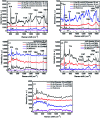Arrayed nanopore silver thin films for surface-enhanced Raman scattering
- PMID: 35517352
- PMCID: PMC9055119
- DOI: 10.1039/d0ra03803b
Arrayed nanopore silver thin films for surface-enhanced Raman scattering
Abstract
Active substrates are crucial for surface-enhanced Raman scattering (SERS). Among these substrates, large uniform area arrayed nanoporous silver thin films have been developed as active substrates. Arrayed nanoporous silver thin films with unique anisotropic morphologies and nanoporous structures can be fabricated onto the nanoporous anodic aluminum oxide (AAO) of controlled pore size and interspacing by precisely tuning the sputtering parameters. These thin films preserve locally enhanced electromagnetic fields by exciting the surface plasmon resonance, which is beneficial for SERS. In this study, nanoporous silver thin films were transferred into polymethylmethacrylate (PMMA) and polydimethylsiloxane (PDMS) substrates using our recently invented template-assisted sol-gel phase inverse-imprinting process to form two different nanopore thin films. The as-formed Ag nanoporous thin films on PMMA and PDMS exhibited intensively enhanced SERS signals using Rhodamine 6G (R6G) as the model molecule. The two nanopore thin films exhibited opposite pore size-dependent SERS tendencies, which were elucidated by the different enhancement tendencies of the electric field around pores of different diameters. In particular, the Ag nanoporous thin film on PMMA exhibited an R6G detection limit of as low as 10-6 mol L-1, and the SERS enhancement factor (EF) was more than 106. The low detection limit and large EF demonstrated the high sensitivity of the as-prepared SERS substrates for label-free detection of biomolecules. Compared with conventional smooth films, this nanopore structure can facilitate future application in biomolecular sensors, which allows the detection of single molecules via an electronic readout without requirement for amplification or labels.
This journal is © The Royal Society of Chemistry.
Conflict of interest statement
There are no conflicts to declare.
Figures




Similar articles
-
Silver Nanopillar Arrayed Thin Films with Highly Surface-Enhanced Raman Scattering for Ultrasensitive Detection.ACS Omega. 2022 Jul 11;7(29):25726-25731. doi: 10.1021/acsomega.2c03022. eCollection 2022 Jul 26. ACS Omega. 2022. PMID: 35910149 Free PMC article.
-
Ingenious Fabrication of Ag-Filled Porous Anodic Alumina Films as Powerful SERS Substrates for Efficient Detection of Biological and Organic Molecules.Biosensors (Basel). 2022 Sep 29;12(10):807. doi: 10.3390/bios12100807. Biosensors (Basel). 2022. PMID: 36290944 Free PMC article.
-
Ag microlabyrinth/nanoparticles coated large-area thin PDMS films as flexible and transparent SERS substrates for in situ detection.Spectrochim Acta A Mol Biomol Spectrosc. 2023 Dec 15;303:123153. doi: 10.1016/j.saa.2023.123153. Epub 2023 Jul 13. Spectrochim Acta A Mol Biomol Spectrosc. 2023. PMID: 37473663
-
Advances in the Fabrication of Nanoporous Anodic Aluminum Oxide and Its Applications to Sensors: A Review.Nanomaterials (Basel). 2023 Oct 27;13(21):2853. doi: 10.3390/nano13212853. Nanomaterials (Basel). 2023. PMID: 37947698 Free PMC article. Review.
-
Nanoporous thin films in optical waveguide spectroscopy for chemical analytics.Anal Bioanal Chem. 2020 May;412(14):3299-3315. doi: 10.1007/s00216-020-02452-8. Epub 2020 Feb 27. Anal Bioanal Chem. 2020. PMID: 32107572 Free PMC article. Review.
Cited by
-
Transfer of AuNRs into AAO Nanoholes via Self-Assembly Method for Ultrasensitive SERS Detection.ACS Omega. 2025 May 2;10(18):18764-18774. doi: 10.1021/acsomega.5c00417. eCollection 2025 May 13. ACS Omega. 2025. PMID: 40385221 Free PMC article.
-
Flexible SERS substrate of silver nanoparticles on cotton swabs for rapid in situ detection of melamine.Nanoscale Adv. 2022 Jan 13;4(4):1164-1172. doi: 10.1039/d1na00670c. eCollection 2022 Feb 15. Nanoscale Adv. 2022. PMID: 36131771 Free PMC article.
-
Highly Sensitive, Robust, and Recyclable TiO2/AgNP Substrate for SERS Detection.Molecules. 2022 Oct 10;27(19):6755. doi: 10.3390/molecules27196755. Molecules. 2022. PMID: 36235289 Free PMC article.
-
High Sensitivity SERS Substrate of a Few Nanometers Single-Layer Silver Thickness Fabricated by DC Magnetron Sputtering Technology.Nanomaterials (Basel). 2022 Aug 10;12(16):2742. doi: 10.3390/nano12162742. Nanomaterials (Basel). 2022. PMID: 36014606 Free PMC article.
-
Silver Nanopillar Arrayed Thin Films with Highly Surface-Enhanced Raman Scattering for Ultrasensitive Detection.ACS Omega. 2022 Jul 11;7(29):25726-25731. doi: 10.1021/acsomega.2c03022. eCollection 2022 Jul 26. ACS Omega. 2022. PMID: 35910149 Free PMC article.
References
-
- Guerrini L. and Alvarez-Puebla R. A., Vibrational Spectroscopy in Protein Research, 2020, pp. 553–567
LinkOut - more resources
Full Text Sources
Miscellaneous

